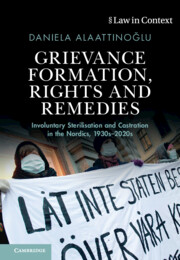 Grievance Formation, Rights and Remedies
Grievance Formation, Rights and Remedies Book contents
- Grievance Formation, Rights and Remedies
- Law in Context
- International Journal of Law in Context: A Global Forum for Interdisciplinary Legal Studies
- Grievance Formation, Rights and Remedies
- Copyright page
- Dedication
- Contents
- Tables
- Foreword
- Acknowledgements
- Abbreviations
- Prologue: Eugenics and the Control of Reproduction and Sexuality
- Part I Developing Rights and Wrongs
- 1 Victims, Harms and Grievance Formation
- Part II A Question of Rights?
- Part III Rights Framing and Grievance Formation
- Bibliography
- Index
1 - Victims, Harms and Grievance Formation
from Part I - Developing Rights and Wrongs
Published online by Cambridge University Press: 18 August 2023
- Grievance Formation, Rights and Remedies
- Law in Context
- International Journal of Law in Context: A Global Forum for Interdisciplinary Legal Studies
- Grievance Formation, Rights and Remedies
- Copyright page
- Dedication
- Contents
- Tables
- Foreword
- Acknowledgements
- Abbreviations
- Prologue: Eugenics and the Control of Reproduction and Sexuality
- Part I Developing Rights and Wrongs
- 1 Victims, Harms and Grievance Formation
- Part II A Question of Rights?
- Part III Rights Framing and Grievance Formation
- Bibliography
- Index
Summary
This chapter introduces the central research agenda, methodology, and scope of the book, centring the concept of grievance formation. Discussing the legal foundations and modalities of remedies in international law, the chapter poses the question of state remedial responsibilities in relation to the passage of time. This is a central question in the globally emerging discussions on whether states ought to remedy sterilisation or castration practices in their past. Furthermore, the chapter lays down the theoretical framework for the book’s use of the concept of grievance formation. As employed in social movement theory, this concept describes the process of people starting to address harmful experiences as common grievances. In this chapter, the concept is initially introduced into legal research by linking it with rights mobilisation: how victims of rights violations redefine traumatic experiences as individual or common grievances, rights violations, and legal harm to be remedied. As such, the concept offers a theoretical framework to understand how and why some victims of rights violations begin to conceptualise themselves as such and demand state responsibility, while others might not; why victims are publicly and institutionally recognised and redressed to different extents.
- Type
- Chapter
- Information
- Grievance Formation, Rights and RemediesInvoluntary Sterilisation and Castration in the Nordics, 1930s–2020s, pp. 17 - 40Publisher: Cambridge University PressPrint publication year: 2023
